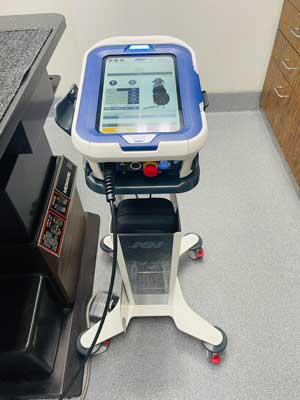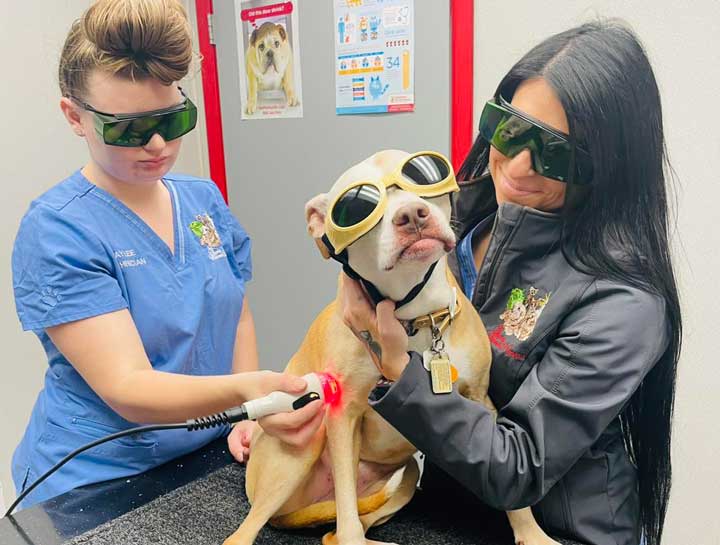Pet Laser Therapy
A non-invasive holistic treatment.
We offer veterinary laser therapy for pets. Laser therapy is a non-invasive holistic treatment used in pet rehabilitation to speed up the body's natural healing process and relieve pain. It’s a great option for post-op pets, older pets, and pets living with chronic conditions like arthritis.
How does pet laser therapy work?
 Laser therapy uses deep penetrating beams of light to alter cells and the tissue that surrounds them. When the light penetrates the body’s cellular components, it stimulates the targeted cells and promotes healing. Perhaps most importantly, though, laser therapy is entirely painless.
Laser therapy uses deep penetrating beams of light to alter cells and the tissue that surrounds them. When the light penetrates the body’s cellular components, it stimulates the targeted cells and promotes healing. Perhaps most importantly, though, laser therapy is entirely painless.
Whether your pet is struggling with post-surgical pain or they’re simply getting older, laser therapy can help them live their very best life. Treatments are relatively quick and can be easily integrated with traditional medical procedures and other holistic practices like acupuncture, reiki, and hydrotherapy.
What conditions can laser therapy treat?
Laser therapy can help treat a number of chronic and acute conditions in pets including:
- Allergies
- Arthritis and inflammation
- Lacerations and burns
- Hip dysplasia and osteoarthritis
- Skin conditions and infections
- Fractures, sprains, and strains
- Gingivitis and tooth extraction pain
- Wound healing and post-surgical pain relief
Answers to some of your most common questions:
What wavelengths are used in the MLS therapy?
MLS therapy uses both the 808nm and 905nm wavelengths simultaneously. The 808nm wavelength is delivered using continuous emission while the 905nm wavelength is delivered using pulsed emission.
Why are two wavelengths used?
MLS Therapy uses two wavelengths to overcome the limits of traditional Laser Therapy. Traditional Laser therapy does not deliver both wave lengths in a reinforcing and synchronized fashion. Continuous laser emissions act fast on inflammation, stimulating blood and lymphatic circulation and inducing fast re-absorption of fluid build ups; however they only have a secondary effect on pain, which is diminished after reducing the inflammatory process. Pulsed laser emissions, on the other hand, have a practically immediate effect on pain, since they are able to induce analgesia, interfering with the very transmission of the pain impulse to the higher brain centers, but they are less effective at treating inflammation and edema.
Is MLS Therapy approved by the FDA?
Yes, the FDA has approved the use of MLS therapy and it is also patented via the US Patent Office.
What is the advantage of MLS therapy over traditional low level lasers? (LLLT)
MLS Therapy is able to induce strong anti-inflammatory, anti-oedema, and analgesic effects simultaneously and within a short period of time. LLLT cannot achieve these results because of the limitations of using one or two wavelengths that are not synchronized. The patented control system that generates the MLS pulse synchronizes the emissions to achieve results previously unattainable. Thanks to this characteristic synchronization, the various therapeutic effects not only take place at the same time but reciprocally reinforce each other.
What is the depth of penetration of the Harmony laser?
The depth of penetration will vary based on the animal but it is safe to assume that it will penetrate 4-5 cm on most animals.
How many treatments are usually needed to get results?
Results can often been seen after the first treatment. Most conditions have protocols that range from 6-10 treatments. The treatments are cumulative and are delivered 2-3 times per week for 2-3 weeks.
How was MLS Therapy developed and tested?
MLS Therapy has been developed and tested following a strict course of biomedical and clinical research. The effectiveness of the combination of the emissions making up the MLS pulse was initially tested in vitro on cellular cultures, then in vivo on animals, and finally by means of controlled clinical trials run by major state-of--the-art health organizations for treating traumatic and degenerative painful diseases.
If you think laser therapy could improve your pet's quality of life, give us a call at (301) 645-2550 to schedule a consultation.

